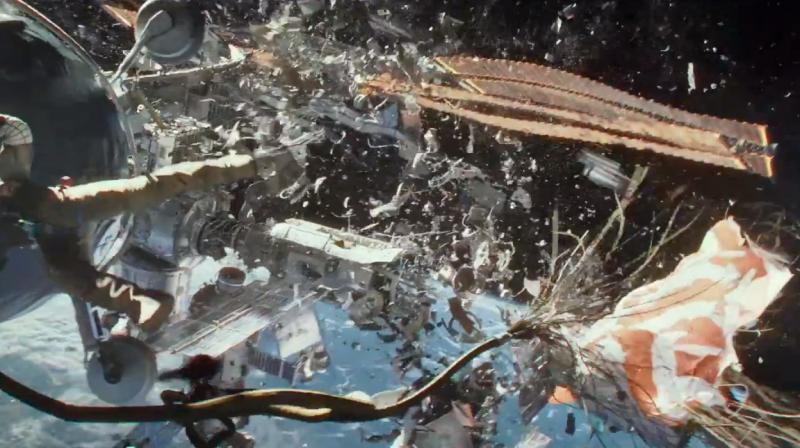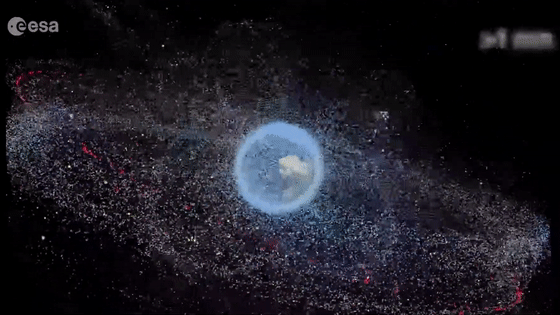
How many satellites can fit in Earth’s orbit?
Share
There may have been a mere thousand or so operational satellites a decade ago, but there will be tens or even hundreds of thousands in 10 years.
For years, experts have warned that Earth's orbit is getting a bit crowded. Is there a limit to how many satellites we can launch into space before it gets overwhelming?
As an astrophysicist and astronomer at the Harvard-Smithsonian Center for Astrophysics, Jonathan McDowell studies super-energetic phenomena in the universe, including jet-emitting black holes in galactic centres. Recently, McDowell has become known for a completely different field of space research. McDowell tracks the growing number of satellite launches as well as the ballooning number of objects orbiting the Earth in his monthly digital circular Jonathan's Space Report.
With the intention of providing a “... pedantic historical record of the space age,” the project has, in some ways, become a chronicle of the destruction of the near-Earth environment. In his frequent media appearances, McDowell has been vocal about his views on the future of the increasingly overcrowded near-Earth space.
"It's going to be like an interstate highway, at rush hour in a snowstorm with everyone driving much too fast," he told Space.com when asked what the situation in orbit will be like if existing plans for satellite mega-constellations such as SpaceX's Starlink, OneWeb and Amazon Kuiper come to fruition. "Except that there are multiple interstate highways crossing each other with no stoplights."
What do manoeuvres really mean?

We are already seeing signs that things are getting tense. Hugh Lewis, McDowell's British colleague, is another voice of caution that tempers the confidence of entrepreneurs caught in the new space gold rush. A professor of astronautics at the University of Southampton in England, Lewis has been publishing regular updates on his Twitter page for the past few years detailing the increasing number of so-called conjunction events, which occur when two objects in space, such as satellites or debris, get dangerously close.
His graphs are sobering to read. In a Twitter post published mid-January, Lewis stated that "the overall number of conjunctions predicted for 2022 was 134% higher than the number for 2020 and 58% higher than 2021, exceeding 4 million."
In other words, Lewis doesn't mean that on 4 million occasions objects in space came close to colliding - just that managing traffic in space is much more difficult than it used to be.
Let's take SpaceX's Starlink as an example. According to information that SpaceX submitted to the US Federal Communications Commission (FCC) in December last year, SpaceX's autonomous collision-avoidance system performed 26,037 orbital avoidance manoeuvres with its Starlink satellites in the two-year period between Dec. 1, 2020, and Nov. 30, 2022.
In other words, each Starlink satellite launched to date has performed 12 avoidance manoeuvres on average.
However, SpaceX's current constellation is smaller than 10% of what the company plans to deploy. The number of Starlink satellites in orbit may reach 42,000 within 10 years. Aside from the 4,000 satellites OneWeb plans to launch, another 3,200 Kuiper craft from Amazon, and 13,000 satellites from China's Guowang system.
SpaceX claims that each of its satellites has enough fuel to perform 350 collision-avoidance manoeuvres over the course of its expected five-year lifetime. Lewis calculated that the number could be reached remarkably soon.
"The number [of required avoidance manoeuvres] is increasing nonlinearly," Lewis said. "By about 2027 or 2028, the Starlink constellation might have made throughout its lifetime a total of a million collision-avoidance manoeuvres. And that also corresponds potentially to the earliest time when they reach 350 collision-avoidance manoeuvres per satellite [per the five-year lifetime period]. We're talking about potentially hundreds, if not thousands of manoeuvres a day."
Because of the sheer number of avoidance manoeuvres they must perform, Starlink satellites may run out of fuel in less than five years from now.
Lewis, however, praises SpaceX's attitude toward space safety. Only five years ago, the company did not have a single satellite in space. Now, it is the world's largest satellite operator. The attitude of SpaceX has improved since it launched its first satellite in 2019. A Starlink satellite's autonomous avoidance system manoeuvres every time it encounters a situation with a 1 in 100,000 chance of colliding. This level of risk is an order of magnitude lower than the threshold used by NASA. SpaceX also assumes responsibility in every conjunction situation and performs a manoeuvre, unless operators of the other satellite involved in the conjunction prefer to do so themselves, the company told the FCC.
Collisions and the aftermath

Operational satellites are only one aspect of the problem. There are 36,500 pieces of space debris larger than 10 centimetres in near-Earth space, 1 million objects 0.4 to 4 inches (1 to 10 cm) in size, and 130 million fragments smaller than 1 cm in size, according to the European Space Agency.
In particular, the amount of smaller particles increases as large objects collide at enormous orbital speeds, forming clouds of fragments.
"There's good evidence that the number of minor collisions is already increasing significantly," McDowell said. "We're seeing debris from objects that shouldn't really be creating debris. They probably have been hit by something small, even if they carry on working afterwards."
Large debris fragments over four inches in size are routinely tracked, but smaller debris fragments and their collisions are mostly unknown.
Debris experts, however, are most concerned about encounters between two large defunct bodies — dead satellites or used rocket stages. One such close approach, between a decades-old Russian rocket upper stage and a long-defunct Russian satellite, took place on the 27th of January. With neither object being able to manoeuvre, space traffic guards could only look on with their fingers crossed, hoping the two would miss each other. On this occasion, they did —by a mere 6 metres. The incident, described as a close call "worst-case scenario," could have spawned thousands of dangerous debris fragments that would have stayed in orbit for centuries, threatening everything in their path.
The combination of increasing numbers of new satellites and the growing amount of orbital junk leads to a perilous situation that in the not-so-distant future may turn some regions of near-Earth space into a dangerous no-go zone.
"Things like [the January 27th incident] will start happening more often," McDowell said. "One collision doesn't change things dramatically, but once we have one a year, you get to a regime where you start to have a lot of losses of satellites. It really will start to affect the economics of low Earth orbit. Companies will start losing serious money because their satellites keep getting destroyed."
So how many satellites can we safely fit into space?
So how many more satellites can Earth orbit safely hold? The answer to this question is not straightforward. Lewis says that certain orbital altitudes are more vulnerable than others. For example, Starlink satellites orbit 550 kilometres above Earth. Objects at this altitude usually don't remain cluttering space for too long after they cease operations. Even if their thrusters fail at the end of their missions and don't bring the craft back to Earth's atmosphere to burn up immediately (as many operators promise), these satellites' orbits naturally decay within a few years, thanks to atmospheric drag. This natural cleansing ability of Earth's orbit, however, declines with altitude.
"The space environment is like a system where you have flows in and flows out," said Lewis. "We launch things into space and the flow coming out, typically, due to atmospheric drag, is the only mechanism we've got really to naturally remove things from the environment. But above 1,000 kilometres, the atmosphere doesn't really do anything, because it's so sparse. There's no sink; the numbers can only go up."
OneWeb's constellation inhabits this treacherous altitude range, and so does the smaller Globalstar.
Most mega constellation operators pledge to ensure their craft have enough fuel left at mission's end to take themselves down where Earth's atmosphere can take care of things. But the likelihood of technical malfunctions still worries experts. In 2012, the European Space Agency, an outspoken champion of sustainable space operations, failed to remove its 8 metric tonnes Earth-observation satellite Envisat from its orbit 772 km above Earth. The craft, which will continue orbiting the planet for centuries, is now among the most dangerous pieces of space debris.
McDowell says that humankind is likely going to discover the natural capacity of near-Earth space "the hard way." Despite the pledges of mega constellation operators, the astrophysicist doubts that things will remain manageable in the years ahead.
"Five or 10 years from now, we'll have somewhere between 20,000 and 100,000 satellites, and I am very sceptical that at the upper number of 100,000 things can be operated safely," McDowell said.
You’ve come this far…
Why not venture a little further into A.S.S. - our exclusive Australian Space Society.
And keep thrusting Australia into the deep unknown…
#Space_Aus





